Pectoral stretch: Health benefits, How to do ?
Pectoral stretch is the important exercise to improve flexibility of your chest muscles mainly Pectoralis major and Pectoralis minor muscles. This exercise helps to improve mobility of chest area and improves your posture.
What is a pectoral stretch?
The pectoral muscle has 2 types: pectoralis major muscle and pectoralis minor muscle. It is located on the right and left sides of the body near the chest. The pec major attaches at the middle of the clavicle and follows down towards the breastbone/lower sternum area. The pec minor is smaller, situated underneath the pec major, ends at the middle of the third, fourth and fifth ribs.
Pectoral stretching is important pectoral stretching is because these stretches work to elongate the chest muscles, allowing for naturally good posture and movement.
The pectoralis is an entire region of the body that is continuously working, as the majority of our motions use it. For instance, when you are doing things in front of your body, such as reaching, pulling or pushing, this is done by pectoralis major muscle; simple everyday activities that we all engage infrequently.
With all this said and their significance stressed, this is also a muscle group that is prone to tightness, which is why pectoralis stretches should not be overlooked.
Chest stretches work to open and loosen your pectoral region, decreasing tightness and as a result, promoting good body motions, better posture and even reducing upper back pain.
What are the advantage of pectoralis stretch?
There are many advantages of pectoralis stretching:
- Improves posture and flexibility
- Increase Range of Motion (ROM)
- Promotes good Circulation to help recover from the workout
- Increase Strength of chest muscles
- Lowering the Risk of muscle strain or injury during your daily workouts, as your muscles become more pliable and supple, and ready to lift the weight.
- Decrease soreness in your muscle if they are tight
What are the types of pectoral muscle stretching?
There are certain types of a pectoral stretch:
- Above-the-head Chest Stretch
- Bent-arm Wall Stretch
- Side-Lying Parallel Arm Chest Stretch
- Towel Chest Stretch
- Doorway Pectoral Stretch
- Lying Pectoral Stretch
- Camel Pose
- Floor Angels
- Corner Chest Stretch
- Chest Opener
- Bosu Ball Chest Stretch
- Bow Pose
- Reverse kneeling stretch
- Chest Stretch With Resistance Band
- Behind-the-back Elbow-to-elbow Grip
Above-the-head Chest Stretch
How to do – Take a standing or sitting position.
Now interlock fingers, and lift your arms above the head.
Gently squeeze your scapulae together and move your elbows and hands backwards.
Vary the height of your hands such as hands behind your head, hands on top of your head, hands a few inches above your head.
If you feel a stretch then hold it 20-30 seconds 2-4 times.
Bent-arm Wall Stretch
How to do – Take a standing position sideways by a wall, and take a split stance position. (Right in front of the left leg and left leg backwards). Your leg is closest to the wall in front.
Place your arm next to the wall up to a 90-degree angle with the elbow at shoulder height. Position your hand and forearm against the wall.
Turn your face away looking to your other shoulder.
Slowly press into the arm placed on the wall.
Raise your chest outwards slightly to feel a deeper stretch in your pectoral.
Hold it 30 seconds with 2-3 times. Repeat on the opposite side.
Side-Lying Parallel Arm Chest Stretch
How to do – Lying prone on your stomach, place both arms out to the sides, palms facing toward the floor, to form the letter, T.
Start to roll onto your left side by pushing yourself with your right hand.
Lift the right leg, bend the knee and place the right foot behind you on the ground for stability. Rest your left temple on the ground.
Keep the right hand on the ground for balance. For an extra stretch, lift the right hand toward the ceiling.
Repeat on the opposite side. Make sure to stretch for 30 seconds and 2-3 times.
Towel Chest Stretch
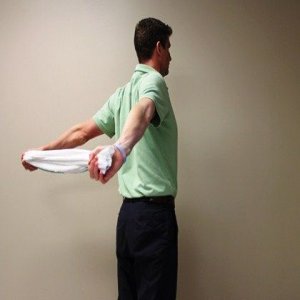
How to do – You need a towel for a stretch.
Stand withholding a towel behind your back. Hold the ends of the towel with your hands.
Raise the towel behind.
Use the towel to slowly pull your shoulders into extension. You feel a stretch in the front of your chest.
Squeeze the scapulae together to feel a deep stretch.
Hold this for 15 to 30 seconds, and then relax.
do it 2-3 times.
Doorway Pectoral Stretch
How to do – Stand in the center of a doorway with the right foot in front of the left foot.
Raise both arms to the sides, bend your elbows at a 90-degree angle and your palms facing forward resting on a doorway.
Shift your weight onto your right leg, leaning forward slightly.
When you feel a stretch, hold that position for 20-30 seconds and repeat it 2-3 times.
Relax and return to the beginning position by stepping back.
Be sure to stand straight, rather than obliquely leaning forward. The front placed your leg should provide a slight lean needed for the stretch.
Lying Pectoral Stretch
How to do – Lie down on the back.
Interlace your fingers and place them under the head.
Now, drag both the elbows backwards for touching to the ground.
It will open up the shoulders and stretch the pectorals.
Hold this stretching position up to 10-30 seconds and do it 2-3 times.
Camel Pose for Pectoral stretch:
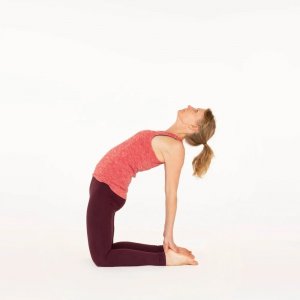
How to do – Take a Kneeling on the exercise mat, with your feet flat, body straight and your hips stacked over the knees – for protection of your sensitive knees, you may place a folded blanket or your mat.
Using one hand, slowly reach back and grab the heel of your feet.
Once both hands are firmly grabbing your heels, take your hips forward so they are positioned over the knees.
Place your head backwards slowly, opening your throat. If this is uncomfortable, you can tuck your chin instead.
Assure you are raising your chest towards the ceiling and use your fully-extended arms for an upward push to the chest and open the stretch further.
Hold this position for 30 seconds.
Now slowly return to the beginning position by bringing the chin back into your chest, drag your hands into your hips to support the lower back as you slowly bring your body to the straight position.
Floor Angels
How to do – Take a supine position with feet should be hip-width apart.
Whole-body resting firmly on the ground.
Position each arms flat on the ground at 90 degrees angle by your side. Your palms face toward the ceiling.
Keeping your body firmly on the floor throughout, slowly lift your arms over your head until they are fully extended.
No hold is needed for this stretch, slowly bring your arms back down to the 90-degree position.
Repeat this movement 10 times until the stretch feels effective.
Corner Chest Stretch
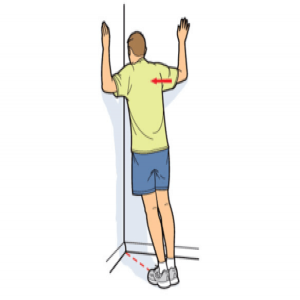
How to do – Take a standing position in a corner of your room and face the wall.
Place your palms and forearms against the wall, approximately at your shoulder level.
Place your feet roughly 1ft away from the corner.
Keeping your forearms and palms positioned and your body straight, lean your body towards the corner.
You should only lean until you feel a stretch across your chest, but not so much that it is causing any discomfort or pain.
Hold it 5-10 seconds.
Move the arms further upward the wall, maintain the same position of forearms and palms against the wall and repeat the leaning and hold.
Bring your arms back down to the starting position at shoulder level and repeat.
Chest Opener
How to do – Start by standing up upright on a flat surface.
Now extend your arm forward at shoulder level with your palms facing toward each other.
Breathe in and move both of your arms out beside you and then back behind your body.
Lean into a stretch, squeezing your scapulae together and moving your chest outwards.
Feel your chest open and hold this position for 3-5 seconds.
Now relax and back to the initial position. (Bring your arms back in front of you with your palms facing each other.)
Repeat this stretch 5 times.
Bosu Ball Chest Stretch
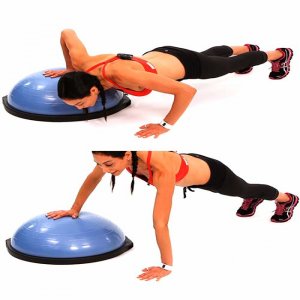
How to do – Start by assuming a plank position on the ground, however, place your left palm on the Bosu Ball, with the right firmly placed on the mat.
Your feet are touching and your hands at shoulder-width apart.
The Bosu Ball is placed to the side of you, sitting just under your left shoulder blade.
Bring down from the upright plank position into a low push-up hold.
Hold the body just a few inches off the floor, keeping your elbows tucked in by the sides.
Maintain a tight body and keep the core engaged throughout the hold.
Hold this position for up to 30 seconds for each arm.
Bow Pose
How to do – Take a prone position on a floor with chin touching to the mat and your palms facing upward by your side.
Bend your knees and bring your heels close to your bottom and it should be hip-width apart.
Raise your hands and take hold of each ankle. Assure to wrap fingers around the ankle, not at the top of your feet. Toes are pointed.
Inhale, pressing your pubic bone downward and moving your lower belly in and up. Raise the heels away from the bottom while maintaining the ankle hold.
Simultaneously, raise your chest, thighs and head upward from the mat. Only your core is touching the ground at this point.
While in the bow position, slide your scapulae down towards each other to open up the chest.
Look straight, hold the pose for up to 20-30 seconds, make sure to focus on your breath, balance and stretch.
Exhale and release the pose with control. Put down your head, thighs, chest back towards the mat. Let go of your ankles, and your feet return to the mat while you move your hands back to your side.
Relax and repeat.
Reverse kneeling stretch
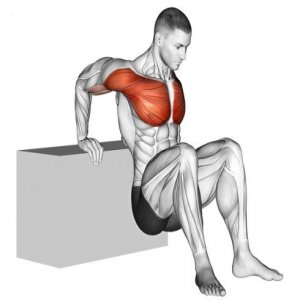
How to do – Start by facing away from the front of a chair and lowering into a dip position, feet flat on the ground hip-width apart.
Place hands at the sides of the chair, palms are facing down beside your hips, with fingers grabbing the front of the seat.
Down your body off the chair until your back is positioned in front of the seat.
Once lowered into the dip, straighten your posture by reaching the chest forward.
Ensure the head is kept upright, facing forward during the whole stretch.
Hold this position for 30-40 seconds of the stretch.
Chest Stretch With Resistance Band
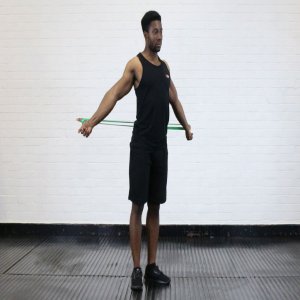
How to do – Stand straight with your feet placed slightly apart.
Grasp hold of each end of the band whilst holding your arms apart just above your waist.
Now, pull each end of the band away from each other to create resistance, form a downward ‘V’ with your arms and assure they are locked straight at all times.
Lift your arms upwards, maintain the ‘V’ position with upright arms and maintain resistance by extending the band.
When your arms are reaching towards the roof, draw your arms and the band backwards behind the body and continue the motion of stretching the band out and towards your hips.
When your arms have re-assumed the ‘V’ position at the end of your back, bring the band to reverse in front of you.
Continue this stretch 5 times.
Behind-the-back Elbow-to-elbow Grip
How to do – Take a position either sitting or standing.
Start with your arms should be hanging by your sides and shoulders pressed down.
Slowly squeeze your scapulae together and open the chest.
Bring your arms behind your back and grip elbow to elbow.
Hold it for 20-30 seconds and relax.
Repeat 2-3 times.
Common Mistakes done during pectoralis stretching
There are some common mistakes done during pectoralis stretching:
- The pulling movement should be gentle, not jerking or sudden.it should be smooth and flowing.
- Don’t stretch freezing muscles. It is good to stretch after a warm-up, after getting out of a shower, or at the end of an exercise. Never stretch freeze muscles – light cardio warm-up first.
- If you feel a stretch more in your shoulder joint than in the chest muscles, which is the aim, change your arm position.
- Always keep a good posture.
- Do Proper breathing – inhale through the nose, exhale through the mouth.
- Hold stretch to the point of mild discomfort, not to the pain level.
- Understand the motive first. The motive of this stretch is to elongate front chest muscles so that tightness does not drag you into feeling that round-shouldered position is the norm or that it is painful to straighten. Feel the stretch in the intentional area.
- Use a mirror to help you to look at a position that how it looks like with what it feels like.
Safety and Precautions in Pectoral stretch:
You could feel a stretch in your chest muscles, but you could not feel any pain. If a stretch causes pain, stop it immediately and see your physical therapist.
Remember to consult with your doctor before starting a stretch of your chest muscles. The physical therapist can help you identify which pectoral stretches are good for your particular needs and your condition.
What should you not do during stretching?
- Don’t press yourself too far. You should feel a mild stretch in your muscles, but stretching shouldn’t be painful.
- Don’t stake to the same stretch over and over.
- Don’t keep your limbs fully straight when you are stretching.
- Do not produce any pain anywhere. The plan is to make things healthier, not to strain, force, push, tighten, grunt, and call that a healthy activity.

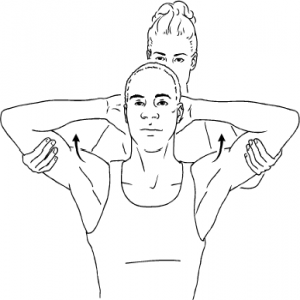

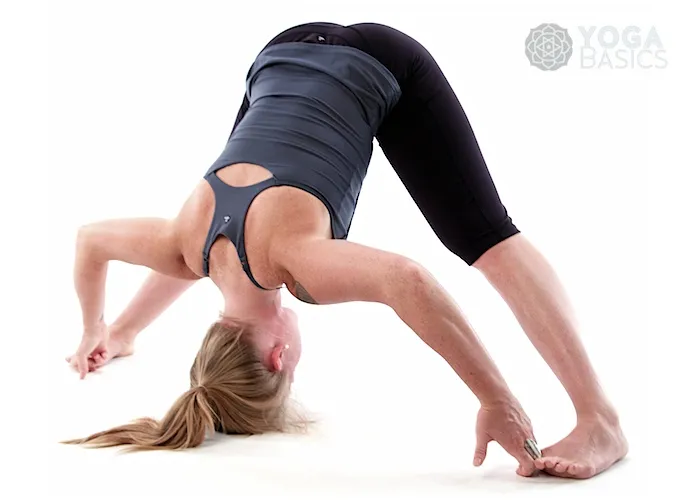
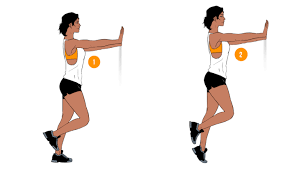
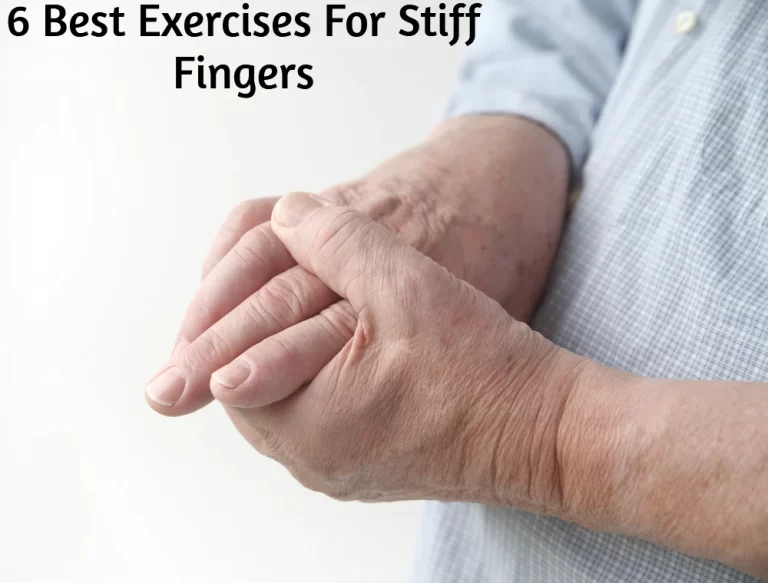
One Comment